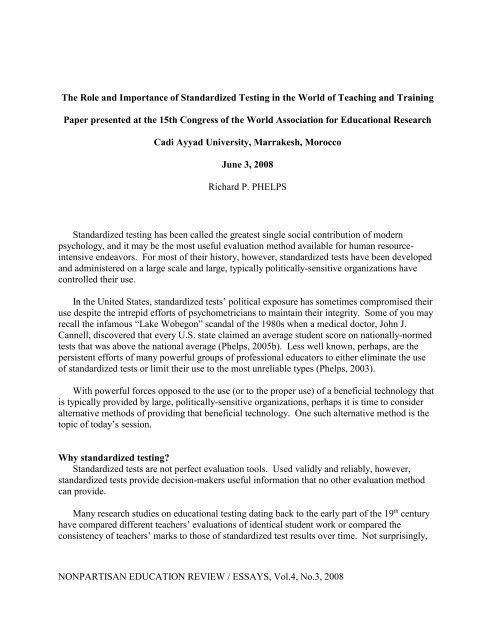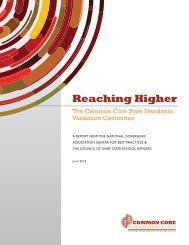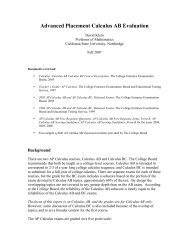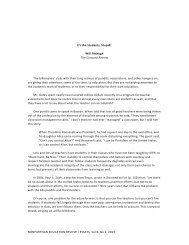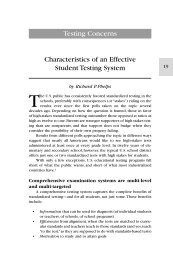Access this essay in .pdf format - Nonpartisan Education Review
Access this essay in .pdf format - Nonpartisan Education Review
Access this essay in .pdf format - Nonpartisan Education Review
Create successful ePaper yourself
Turn your PDF publications into a flip-book with our unique Google optimized e-Paper software.
The Role and Importance of Standardized Test<strong>in</strong>g <strong>in</strong> the World of Teach<strong>in</strong>g and Tra<strong>in</strong><strong>in</strong>g<br />
Paper presented at the 15th Congress of the World Association for <strong>Education</strong>al Research<br />
Cadi Ayyad University, Marrakesh, Morocco<br />
June 3, 2008<br />
Richard P. PHELPS<br />
Standardized test<strong>in</strong>g has been called the greatest s<strong>in</strong>gle social contribution of modern<br />
psychology, and it may be the most useful evaluation method available for human resource<strong>in</strong>tensive<br />
endeavors. For most of their history, however, standardized tests have been developed<br />
and adm<strong>in</strong>istered on a large scale and large, typically politically-sensitive organizations have<br />
controlled their use.<br />
In the United States, standardized tests’ political exposure has sometimes compromised their<br />
use despite the <strong>in</strong>trepid efforts of psychometricians to ma<strong>in</strong>ta<strong>in</strong> their <strong>in</strong>tegrity. Some of you may<br />
recall the <strong>in</strong>famous “Lake Wobegon” scandal of the 1980s when a medical doctor, John J.<br />
Cannell, discovered that every U.S. state claimed an average student score on nationally-normed<br />
tests that was above the national average (Phelps, 2005b). Less well known, perhaps, are the<br />
persistent efforts of many powerful groups of professional educators to either elim<strong>in</strong>ate the use<br />
of standardized tests or limit their use to the most unreliable types (Phelps, 2003).<br />
With powerful forces opposed to the use (or to the proper use) of a beneficial technology that<br />
is typically provided by large, politically-sensitive organizations, perhaps it is time to consider<br />
alternative methods of provid<strong>in</strong>g that beneficial technology. One such alternative method is the<br />
topic of today’s session.<br />
Why standardized test<strong>in</strong>g<br />
Standardized tests are not perfect evaluation tools. Used validly and reliably, however,<br />
standardized tests provide decision-makers useful <strong>in</strong><strong>format</strong>ion that no other evaluation method<br />
can provide.<br />
th<br />
Many research studies on educational test<strong>in</strong>g dat<strong>in</strong>g back to the early part of the 19 century<br />
have compared different teachers’ evaluations of identical student work or compared the<br />
consistency of teachers’ marks to those of standardized test results over time. Not surpris<strong>in</strong>gly,<br />
NONPARTISAN EDUCATION REVIEW / ESSAYS, Vol.4, No.3, 2008
2 NONPARTISAN EDUCATION REVIEW / ESSAYS Vol. 4, No.3<br />
researchers found wide variance from teacher to teacher <strong>in</strong> grad<strong>in</strong>g identical student work or<br />
over time with the same teacher.<br />
In the 1910s, for example, researchers Starch and Elliott (1912) made copies of two actual<br />
English exam<strong>in</strong>ation papers and sent them to teachers to grade and return. The marks ranged<br />
from 50 to 98 percent. One paper, graded by 142 teachers, received fourteen marks below 80<br />
percent and fourteen above 94 percent. “That is, a paper which was considered too poor for a<br />
pass<strong>in</strong>g grade by some teachers was rated as excellent by others.”<br />
Starch and Elliot repeated the procedure with duplicate Geometry tests (1913). Teachers’<br />
marks on the 116 returned papers ranged from 28 to 92 percent, with twenty grades below 60<br />
percent and n<strong>in</strong>e of 85 percent and above. Accord<strong>in</strong>g to L<strong>in</strong>coln and Workman (1936, 7):<br />
This type of experiment has been repeated many times by <strong>in</strong>vestigators and always<br />
with similar results. Therefore there is abundant evidence that teachers’ marks are a<br />
very unreliable means of measurement.<br />
Without standardized tests (or standardized grad<strong>in</strong>g protocols) <strong>in</strong> education, we would<br />
<strong>in</strong>crease our reliance on <strong>in</strong>dividual teacher grad<strong>in</strong>g and test<strong>in</strong>g. Are teacher evaluations free of<br />
standardized test<strong>in</strong>g’s alleged fail<strong>in</strong>gs No. Individual teachers can narrow the curriculum to<br />
that which they prefer. Grades are susceptible to <strong>in</strong>flation with ord<strong>in</strong>ary teachers, as students get<br />
to know a teacher better and learn his idiosyncrasies. A teacher’s (or school’s) grades and test<br />
scores are far less likely to be generalizable than any standardized tests’ (See, for example,<br />
Gullickson & Ellwe<strong>in</strong>, 1985; Impara & Plake, 1996; Stigg<strong>in</strong>s, Frisbee, & Griswold, 1989;<br />
Woodruff & Ziomek, 2004a, 2004b). (In Phelps, 2008, Table 1 lists some common fallacies<br />
proffered by test<strong>in</strong>g opponents, along with citations to responsible refutations.)<br />
Accord<strong>in</strong>g to the research on the topic, many U.S teachers consider “nearly everyth<strong>in</strong>g”<br />
when assign<strong>in</strong>g marks, <strong>in</strong>clud<strong>in</strong>g student class participation, perceived effort, progress over the<br />
period of the course, and comportment, accord<strong>in</strong>g to one researcher. Actual achievement vis-àvis<br />
the subject matter is just one factor. One study of teacher grad<strong>in</strong>g practices discovered that<br />
66 percent of teachers felt that their perception of a student’s ability should be taken <strong>in</strong>to<br />
consideration <strong>in</strong> award<strong>in</strong>g the f<strong>in</strong>al grade (Frary, Cross, & Weber 1993).<br />
When <strong>in</strong>dividual teachers, or <strong>in</strong>dividual employers for that matter, are given the<br />
responsibility to make judgments unanchored by common standards or rules, those judgments<br />
tend to float freely <strong>in</strong> the currents of time, fitt<strong>in</strong>g first one context, then another, and then<br />
another. Be<strong>in</strong>g idiosyncratic to each particular, temporary context, each free-float<strong>in</strong>g evaluation<br />
result is not generalizable to any permanent context. It is a judgment that makes sense only to a<br />
particular teacher or employer at a particular po<strong>in</strong>t <strong>in</strong> time and space.<br />
When I was young, standardized tests were often called “objective tests,” which implied that<br />
teacher-made tests were “subjective.” Standardized tests’ clear separation from the <strong>in</strong>fluence of<br />
local decision-makers, be they classroom teachers or personnel managers responsible for hir<strong>in</strong>g
Phelps: The Role and Importance of Test<strong>in</strong>g 3<br />
new employees, rema<strong>in</strong>s one of their most beneficial features. The adoption of standardized<br />
university admission test<strong>in</strong>g <strong>in</strong> the United States <strong>in</strong> the mid-twentieth century, for example,<br />
helped to pave the way for m<strong>in</strong>orities who lacked the familial connections and social pedigree of<br />
wealthy WASPs (i.e., White, Anglo-Saxon Protestants).<br />
Accord<strong>in</strong>g to Professor Stephen G. Sireci (2005, 113), the bad reputation of standardized<br />
tests portrayed by some critics “is an undeserved one.” He cont<strong>in</strong>ues<br />
People accuse standardized tests of be<strong>in</strong>g unfair, biased and discrim<strong>in</strong>atory. Believe it<br />
or not, standardized tests are actually designed to promote test fairness. Standardized<br />
simply means that the test content is equivalent across adm<strong>in</strong>istrations and that the<br />
conditions under which the test is adm<strong>in</strong>istered are the same for all test takers.<br />
…Standardized tests are used to provide objective <strong>in</strong><strong>format</strong>ion. For example,<br />
employment tests are used to avoid unethical hir<strong>in</strong>g practices (e.g., nepotism, ethnic<br />
discrim<strong>in</strong>ation, etc.). If an assessment system uses tests that are not standardized, the<br />
system is likely to be unfair to many candidates.<br />
There is more to subjectivity <strong>in</strong> decision-mak<strong>in</strong>g than ethnic, racial, gender, or class bias,<br />
however. The fact is that true objectivity requires too much time to be practical <strong>in</strong> mak<strong>in</strong>g<br />
everyday decisions. Double-bl<strong>in</strong>d controlled experiments or program evaluations with random<br />
assignment require time, money, and tra<strong>in</strong>ed professional observation to monitor their progress.<br />
In our daily lives, we make judgments and decisions cont<strong>in</strong>uously. We cannot set up a<br />
controlled experiment, and wait for the results, every time we must choose which laundry<br />
detergent to purchase, where to go on vacation or, for that matter, whom to hire for a job or<br />
whom to admit to the last available place at university.<br />
The time-sav<strong>in</strong>g decision-mak<strong>in</strong>g technique we typically use to get on with our lives,<br />
th<br />
apparently, is Bayesian reason<strong>in</strong>g, named for the early 18 -century statistician Thomas Bayes.<br />
In Bayesian reason<strong>in</strong>g, we employ what relevant prior knowledge we have to each decision. We<br />
calculate the “subjective probabilities,” which are not, <strong>in</strong> the strictest mean<strong>in</strong>g of the term really<br />
“subjective.” More accurately, they are <strong>in</strong>complete probabilities that <strong>in</strong>corporate the <strong>in</strong><strong>format</strong>ion<br />
we have accumulated that is relevant to the matter at hand. That <strong>in</strong><strong>format</strong>ion may be reliable or<br />
not, verified or not, true or not. Nonetheless, until we discover a Founta<strong>in</strong> of Youth to provide<br />
us everlast<strong>in</strong>g life, we must rely on Bayesian reason<strong>in</strong>g as a time-sav<strong>in</strong>g heuristic to negotiate<br />
our lives <strong>in</strong> the short time allotted to each of us (“Bayes Rules,” 2006).<br />
Thus, a standardized test is more than an antidote to biased judgment. We need standardized<br />
tests because each of us is a prisoner of our own limited experiences and observations.<br />
Standardized tests provide an opportunity to make decisions about <strong>in</strong>dividuals that are free of<br />
subjectivity, be that subjectivity due to bias or Bayesian shortcuts. In develop<strong>in</strong>g standardized<br />
tests, tra<strong>in</strong>ed professionals collect empirical data, apply statistical benchmarks, and make<br />
detached, objective evaluations.
4 NONPARTISAN EDUCATION REVIEW / ESSAYS Vol. 4, No.3<br />
Standardized test<strong>in</strong>g: The long view<br />
Standardized tests have provided <strong>in</strong><strong>format</strong>ion for mak<strong>in</strong>g important decisions at least s<strong>in</strong>ce<br />
the first adm<strong>in</strong>istration of the Ch<strong>in</strong>ese civil service exam<strong>in</strong>ation many centuries ago (Zeng, 1999,<br />
8). The “scientific” standardized test (with statistically-calibrated score scales), however, is just<br />
a century old (Phelps, 2007b, chapter 2). The <strong>in</strong>novators responsible for the development of the<br />
scientific standardized test—e.g., B<strong>in</strong>et, Simon, Rice, Thorndike—though, likely would be<br />
amazed by the improvements made <strong>in</strong> test<strong>in</strong>g technology with<strong>in</strong> the relatively brief period<br />
s<strong>in</strong>ce—e.g., computer-adaptive test<strong>in</strong>g or open-source, Web-based platforms, such as the<br />
Exam<strong>in</strong>ation Assessment Management System (ExAMS).<br />
It would seem that test<strong>in</strong>g technology has improved over time exponentially. Test<br />
developers have <strong>in</strong>creased the complexity and technical sophistication of their product <strong>in</strong><br />
response to market and regulatory demands. Today’s standardized tests are better <strong>in</strong> most every<br />
way than their progenitors. They provide more <strong>in</strong><strong>format</strong>ion for the price, and they are more<br />
reliable, fair, and valid (when used as they are designed to be used).<br />
But, the exponential rate of improvement carries some risk. At the same time standardized<br />
tests have improved <strong>in</strong> quality and convenience, they have become more difficult for the average<br />
person or policymaker to understand. Most standardized tests adm<strong>in</strong>istered a century ago were<br />
simply larger-scale, standardized versions of an ord<strong>in</strong>ary classroom teacher’s exam<strong>in</strong>ation. In all<br />
apparent aspects, they looked familiar to the average exam<strong>in</strong>ee.<br />
Some of today’s standardized tests might seem to the average citizen or policymaker as<br />
different <strong>in</strong> character from their 100-year-old ancestors as today’s airplanes or automobiles do<br />
from their 100-year-old antecedents. Any of you who have tried <strong>in</strong> pla<strong>in</strong> language to expla<strong>in</strong> to<br />
policy makers the concepts of item response theory, differential item function<strong>in</strong>g, computeradaptive<br />
test<strong>in</strong>g, or po<strong>in</strong>t-biserial correlation will know what I mean.<br />
The comb<strong>in</strong>ation of technical complexity and the widespread use of test<strong>in</strong>g for public<br />
purposes should elicit a clear, measured, and open public discussion on test<strong>in</strong>g policy. And, I<br />
hope that it does where you live. In the United States, unfortunately, the public and<br />
policymakers are generally showered with obfuscation, mis<strong>in</strong><strong>format</strong>ion, and dis<strong>in</strong><strong>format</strong>ion.<br />
The test<strong>in</strong>g policy debate <strong>in</strong> the United States: The sound of one hand clapp<strong>in</strong>g<br />
Standardized test<strong>in</strong>g <strong>in</strong> the United States is an enigma. Arguably, the country hosts much of<br />
the world’s most advanced technical research and <strong>in</strong>novation. Yet, debates on test<strong>in</strong>g policy<br />
rema<strong>in</strong> primitive and one-sided.<br />
The late economist Mancur Olsen (1965, 1982) developed a theory to expla<strong>in</strong> the political<br />
power of “special <strong>in</strong>terests” <strong>in</strong> democratic societies. Individuals jo<strong>in</strong> groups that provide private<br />
benefits, such as protection aga<strong>in</strong>st market competition, disruptive technologies, or other<br />
challenges to the familiarity and security of the status quo like those portended by externallyimposed<br />
evaluations of performance, such as standardized tests. While the benefits to members
Phelps: The Role and Importance of Test<strong>in</strong>g 5<br />
of the group (e.g., a professional association of educators) can be large (e.g., the absence of<br />
standardized test<strong>in</strong>g programs) the costs (e.g., lowered student achievement, a less efficient<br />
education or employment system) tend to be diffused over society at large and may not even be<br />
noticed by those who bear them. Special <strong>in</strong>terests accrete more and more private benefits (and<br />
political power) over time, however, until they become “vested” <strong>in</strong>terests—wealthy, powerful,<br />
and entrenched.<br />
Olson’s theory is particularly applicable to education <strong>in</strong> the United States, because its<br />
governance is so widely dispersed. Each of the 50 states is constitutionally responsible for<br />
public education and, <strong>in</strong> 49 states, some governance and tax<strong>in</strong>g authority is further deferred to<br />
local school districts, which are typically governed separately from other local units of<br />
government. Some national associations of educators ma<strong>in</strong>ta<strong>in</strong> substantial memberships <strong>in</strong> each<br />
and every local school district, state legislative district, U.S. congressional district, and<br />
television, radio, and newspaper media market. They can saturate the country with the policyrelated<br />
<strong>in</strong><strong>format</strong>ion they prefer and block out the <strong>in</strong><strong>format</strong>ion dissem<strong>in</strong>ation efforts of less<br />
powerful <strong>in</strong>dividuals or groups that offer contrary po<strong>in</strong>ts of view.<br />
In the United States, society’s understand<strong>in</strong>g of standardized test<strong>in</strong>g may be shr<strong>in</strong>k<strong>in</strong>g. The<br />
technical psychometric research literature would seem to be safe. But, the research literature<br />
related to test<strong>in</strong>g policy (i.e., its adm<strong>in</strong>istration, program structure, use, extent, effects, cost,<br />
benefits, public op<strong>in</strong>ion, research dissem<strong>in</strong>ation) is dim<strong>in</strong>ish<strong>in</strong>g. There are simply too few who<br />
cite the research literature <strong>in</strong> any substantial depth or breadth, and too many will<strong>in</strong>g to declare it<br />
barren.<br />
The most common debat<strong>in</strong>g tactic of test<strong>in</strong>g opponents is to avoid debate (Phelps, 2007a).<br />
Whereas scientists seek the scrut<strong>in</strong>y of their peers <strong>in</strong> order to confirm (or deny) the value of their<br />
work, advocates tend to avoid scrut<strong>in</strong>y, especially when sell<strong>in</strong>g falsehoods. Scientists do not<br />
circumvent the research literature, but engage it. They respond to rival hypotheses with<br />
counterevidence. They confront conflict<strong>in</strong>g scientific results. Advocates, however, simply<br />
ignore them. The easiest way to w<strong>in</strong> a debate is by not <strong>in</strong>vit<strong>in</strong>g an opponent. Test<strong>in</strong>g critics<br />
rightly fear an open, fair scientific contest.<br />
Indeed, it has become quite common for test<strong>in</strong>g opponents to declare nonexistent an<br />
enormous research literature that contradicts their claims. With the help of the fourth estate<br />
(Lieberman, 2007, chapter 11), they have been fairly successful <strong>in</strong> eradicat<strong>in</strong>g from the<br />
collective memory thousands of studies conducted by earnest researchers over the course of a<br />
century.<br />
In one effort of m<strong>in</strong>e—accumulat<strong>in</strong>g studies on the effects of standardized test<strong>in</strong>g—I started<br />
out th<strong>in</strong>k<strong>in</strong>g that there were a dozen or so. A few years ago I knew that there were hundreds.<br />
Now I know that their number exceeds a thousand. (In Phelps, 2008, Table 2 provides a brief<br />
synopsis of the research literature.)
6 NONPARTISAN EDUCATION REVIEW / ESSAYS Vol. 4, No.3<br />
In the end, however, it will not matter for society’s sake if we f<strong>in</strong>d ten thousand studies.<br />
There will rema<strong>in</strong> other education researchers, prom<strong>in</strong>ent and with hugely abundant resources at<br />
their disposal—researchers whose work is frequently covered by U.S. education<br />
journalists—who will cont<strong>in</strong>ue to <strong>in</strong>sist that no such studies ever existed. It is U.S. education<br />
research’s dirty big secret: research that generates results that are unpopular among the vested<br />
<strong>in</strong>terests can be successfully—and easily—censored and suppressed (see, for example, Phelps,<br />
1999; 2000; 2003, Preface & chapter 7; 2005a, chapter 3).<br />
Wildlife conservationists tell us that a biological species cannot survive when mat<strong>in</strong>g<br />
<strong>in</strong>dividuals cannot f<strong>in</strong>d each other. When numbers decl<strong>in</strong>e to such an extent that predators (or<br />
hunters) can more easily f<strong>in</strong>d members of the species than can potential mates, the species<br />
crosses a demographic threshold and heads toward its <strong>in</strong>evitable ext<strong>in</strong>ction. Those who work<br />
with endangered species call <strong>this</strong> the “ext<strong>in</strong>ction vortex.”<br />
Similarly, the censorship and suppression of the research literature on the effects of<br />
educational achievement test<strong>in</strong>g has become so successful that it has become difficult to f<strong>in</strong>d its<br />
progenitors. For example, I may have spent more time than anyone comb<strong>in</strong>g the research<br />
literature. Nonetheless, I was a few years <strong>in</strong>to my effort before I discovered the work of Frank<br />
Dempster (1991, 1997), one of the world’s foremost authorities, or that of Jim Haynie who<br />
works <strong>in</strong> career and technical education. Why did it take me so long to f<strong>in</strong>d their work Their<br />
work is not popular among the vested <strong>in</strong>terests <strong>in</strong> education—they f<strong>in</strong>d the benefits of test<strong>in</strong>g to<br />
be strong and persistent—thus it is not widely advertised.<br />
One hundred years of research and experience left beh<strong>in</strong>d<br />
Indeed, the No Child Left Beh<strong>in</strong>d (NCLB) Act, passed by the U.S. Congress <strong>in</strong> 2002, could<br />
have been <strong>in</strong>formed by a cornucopia of research and experience. Instead, it was <strong>in</strong>formed by<br />
virtually none. Prior research and experience would have told policymakers that most of the<br />
motivational benefits of standardized tests required consequences for the students and not just<br />
for the schools. Those stakes needn’t be very high to be effective, but there must be some. As<br />
NCLB imposes stakes on schools, but not on students, who knows if the students even try to<br />
perform well.<br />
Prior research and experience would have <strong>in</strong>formed policymakers that educators are<br />
<strong>in</strong>telligent people who respond to <strong>in</strong>centives, and who will game a system if they are given an<br />
opportunity to do so (see, for example, Cannell, 1987, 1989). The NCLB Act left many aspects<br />
of the test adm<strong>in</strong>istration process that profoundly affect scores (e.g., <strong>in</strong>centives and motivation,<br />
cut scores, degree of curricular alignment) up for grabs and open to manipulation by local and<br />
state officials.<br />
Prior research and experience would have <strong>in</strong>formed policymakers that different tests get<br />
different results and one should not expect average scores from different tests to rise and fall <strong>in</strong><br />
unison over time (as some <strong>in</strong>terpreters of the NCLB Act seem to expect with the National<br />
Assessment of <strong>Education</strong>al Progress [NAEP] benchmark) (Phelps, 2005b).
Phelps: The Role and Importance of Test<strong>in</strong>g 7<br />
Prior research and experience would have <strong>in</strong>formed policymakers that the public was not <strong>in</strong><br />
favor of punish<strong>in</strong>g poorly-perform<strong>in</strong>g schools (as NCLB does), but was <strong>in</strong> favor of apply<strong>in</strong>g<br />
consequences to poorly-perform<strong>in</strong>g students and teachers (which NCLB does not) (see, for<br />
example, Phelps 2005a, chapter 1).<br />
What are the effects of test-based accountability Table 3 <strong>in</strong> chapter 3 of the forthcom<strong>in</strong>g<br />
Correct<strong>in</strong>g fallacies about educational and psychological test<strong>in</strong>g (Phelps, 2008) lists just a small<br />
sample of useful, <strong>in</strong>sightful, relevant studies that effectively answered <strong>this</strong> question, could have<br />
<strong>in</strong>formed the design of NCLB, and have been declared by prom<strong>in</strong>ent educators to not exist.<br />
Had the policymakers and planners <strong>in</strong>volved <strong>in</strong> design<strong>in</strong>g the NCLB Act simply read the<br />
freely-available research literature <strong>in</strong>stead of fund<strong>in</strong>g expensive new studies and wait<strong>in</strong>g for their<br />
few results, they would have received more value for their money, gotten more and better<br />
<strong>in</strong><strong>format</strong>ion, and gotten it earlier when they actually needed it.<br />
With the s<strong>in</strong>gle exception of the federal mandate, there was no aspect of the NCLB<br />
accountability <strong>in</strong>itiative that had not been tried and studied before. Every one of the NCLB<br />
Act’s fail<strong>in</strong>gs was perfectly predictable, based on decades of prior experience and research.<br />
Moreover, there were better alternatives for every characteristic of the program that had also<br />
been tried and studied thoroughly by researchers <strong>in</strong> psychology, education, and program<br />
evaluation. Yet, policymakers were made aware of none of then.<br />
The result<strong>in</strong>g scantily-<strong>in</strong>formed public policy <strong>in</strong>cludes a national test<strong>in</strong>g program that would<br />
hardly be recognizable anywhere outside of North America. The standardized test<strong>in</strong>g<br />
component of NCLB <strong>in</strong>cludes no consequences for the students. This sends the sublim<strong>in</strong>al<br />
message to the students that they need not work very hard and the test<strong>in</strong>g’s largest potential<br />
benefit—motivation—is not even accrued.<br />
By contrast, schools are held accountable for students’ test performance; they are held<br />
responsible for the behavior of other human be<strong>in</strong>gs over whom they have little control.<br />
Moreover, the most important potential supporters of test<strong>in</strong>g programs—classroom teachers and<br />
school adm<strong>in</strong>istrators—are alienated, put <strong>in</strong>to the demean<strong>in</strong>g position of cajol<strong>in</strong>g students to<br />
cooperate.<br />
Tak<strong>in</strong>g test<strong>in</strong>g directly to the people<br />
I <strong>in</strong>terpret the highly successful censorship and suppression of a century’s research literature<br />
on the effects of standardized test<strong>in</strong>g to be evidence that the vested <strong>in</strong>terests <strong>in</strong> U.S. education<br />
now control the test<strong>in</strong>g policy debate. This is lamentable; but what does it have to do with<br />
today’s topic<br />
Quite a lot, as it turns out. When the forces of censorship and suppression ga<strong>in</strong> effective<br />
control of the ma<strong>in</strong> routes of <strong>in</strong><strong>format</strong>ion dissem<strong>in</strong>ation, the only way for others to reach the
8 NONPARTISAN EDUCATION REVIEW / ESSAYS Vol. 4, No.3<br />
public is via alternative routes. Where entrenched <strong>in</strong>terests attempt to impede communication<br />
between test<strong>in</strong>g producers and test<strong>in</strong>g consumers, it is only natural that the two <strong>in</strong>terested parties<br />
should try to communicate directly. And, that is where the <strong>in</strong>novation of Web-based opensource<br />
platforms fits <strong>in</strong>.<br />
Hopefully, Web-based open-source test<strong>in</strong>g platforms will not only facilitate the spread of<br />
high-quality test<strong>in</strong>g use but also its understand<strong>in</strong>g. As more and more test users learn how to use<br />
the technology they simultaneously become better <strong>in</strong>formed citizens not only about a technology<br />
but about public policies related to test<strong>in</strong>g.<br />
References<br />
Bayes Rules. (2006, January 5). The Economist. Retrieved April 27, 2008 from<br />
http://www.economist.com/science/displaystory.cfmstory_id=E1_VPVQGJG<br />
Cannell, J.J. (1987). Nationally normed elementary achievement test<strong>in</strong>g <strong>in</strong> America’s public<br />
nd<br />
schools: How all fifty state are above the national average. (2 Ed.), Daniels, WV, USA:<br />
Friends for <strong>Education</strong>.<br />
Cannell, J.J. (1989). How public educators cheat on standardized achievement tests.<br />
Albuquerque, NM, USA: Friends for <strong>Education</strong>.<br />
Dempster, F. N. (1991, April). Synthesis of research on reviews and tests, <strong>Education</strong>al<br />
Leadership, 71–76.<br />
Dempster, F. N. (1997). Us<strong>in</strong>g tests to promote classroom learn<strong>in</strong>g. (pp. 332–346). In R. F.<br />
Dillon, (Ed.). Handbook on test<strong>in</strong>g. Westport, CT, USA: Greenwood Press.<br />
Frary, R. B., Cross, L. H., & Weber, L. J. (1993). Test<strong>in</strong>g and grad<strong>in</strong>g practices and op<strong>in</strong>ions of<br />
secondary school teachers of academic subjects: Implications for <strong>in</strong>struction <strong>in</strong> measurement,<br />
<strong>Education</strong>al Measurement: Issues and Practice, 12(3), 23+.<br />
Gullickson, A.R. & Ellwe<strong>in</strong>, M. C. (1985). Post-hoc analysis of teacher-made tests: The<br />
goodness of fit between prescription and practice. <strong>Education</strong>al Measurement: Issues and<br />
Practice, 4(1), 15–18.<br />
Impara, J. C. & Plake, B. S. (1996). Professional development <strong>in</strong> student assessment for<br />
educational adm<strong>in</strong>istrators. <strong>Education</strong>al Measurement: Issues and Practice, 15(2), 14–20.<br />
Lieberman, M. (2007). The educational morass. Lanham, MD, USA: Rowman & Littlefield.<br />
L<strong>in</strong>coln, E. A., & Workman, L. L. (1936). Test<strong>in</strong>g and the uses of test results. New York, NY,<br />
USA: Macmillan.<br />
Olson, M. (1965). The logic of collective action: Public goods and the theory of groups,<br />
Cambridge, MA, USA: Harvard University Press.<br />
Olson, M. (1982). The rise and decl<strong>in</strong>e of nations: Economic growth, stagflation, and social<br />
rigidities, New Haven, CT, USA: Yale University Press.<br />
Phelps, R. P., (1999, April). <strong>Education</strong> establishment bias A look at the National Research<br />
Council’s critique of test utility studies, The Industrial-Organizational Psychologist, 36(4),<br />
37–49.<br />
Phelps, R. P. (2000, W<strong>in</strong>ter). Estimat<strong>in</strong>g the cost of systemwide student test<strong>in</strong>g <strong>in</strong> the United<br />
States. Journal of <strong>Education</strong> F<strong>in</strong>ance, 343–380.
Phelps: The Role and Importance of Test<strong>in</strong>g 9<br />
Phelps, R. P. (2003). Kill the messenger: The war on standardized test<strong>in</strong>g. New Brunswick, NJ,<br />
USA: Transaction Publishers.<br />
Phelps, R. P., Ed. (2005a). Defend<strong>in</strong>g standardized test<strong>in</strong>g. Mahwah, NJ, USA: Lawrence<br />
Erlbaum.<br />
Phelps, R.P. (2005b). The source of Lake Wobegon. <strong>Nonpartisan</strong> <strong>Education</strong> <strong>Review</strong> / Articles,<br />
1(2). Retrievable at http://www.npe.ednews.org/<strong>Review</strong> /Articles/v1n2.htm<br />
Phelps, R.P. (2007a). The dissolution of education knowledge. <strong>Education</strong>al Horizons, 85(4),<br />
232–247.<br />
Phelps, R.P. (2007b). Standardized test<strong>in</strong>g primer. New York, NY, USA: Peter Lang.<br />
Phelps, R.P. (2008). <strong>Education</strong>al achievement test<strong>in</strong>g fallacies, Chapter 3 <strong>in</strong> R.P. Phelps (Ed.),<br />
Correct<strong>in</strong>g fallacies about educational and psychological test<strong>in</strong>g. Wash<strong>in</strong>gton, DC, USA:<br />
American Psychological Association.<br />
Sireci, S. G. (2005). The most frequently unasked questions about test<strong>in</strong>g. In R. P. Phelps (Ed.).<br />
Defend<strong>in</strong>g standardized test<strong>in</strong>g (111–122). Mahwah, NJ, USA: Lawrence Erlbaum.<br />
Starch, D., & Elliot, E. C. (1912). Reliability of the grad<strong>in</strong>g of high school work <strong>in</strong> English.<br />
School <strong>Review</strong>, 21, 442–457.<br />
Starch, D., & Elliot, E. C. (1913). Reliability of grad<strong>in</strong>g work <strong>in</strong> mathematics. School <strong>Review</strong>,<br />
22, 254–259.<br />
Stigg<strong>in</strong>s, R. J., Frisbee, D. A. & Griswold, P. A. (1989). Inside high school grad<strong>in</strong>g practices:<br />
Build<strong>in</strong>g a research agenda, <strong>Education</strong>al Measurement: Issues and Practice. 8(2), 5–14.<br />
Woodruff, D. J., & Ziomek, R. L. (2004a, March). Differential grad<strong>in</strong>g standards among high<br />
schools. ACT Research Report 2004-2, Iowa City, IA, USA: ACT.<br />
Woodruff, D. J., & Ziomek, R. L. (2004b, March). High School Grade Inflation from 1991 to<br />
2003. ACT Research Report 2004-4, Iowa City, IA, USA: ACT.<br />
Zeng, K. (1999). Dragon gate: Competitive exam<strong>in</strong>ations and their consequences. London, UK:<br />
Cassell.


